Sailing yacht vs. motorboat: Boat swap at 8 Beaufort - two editors report
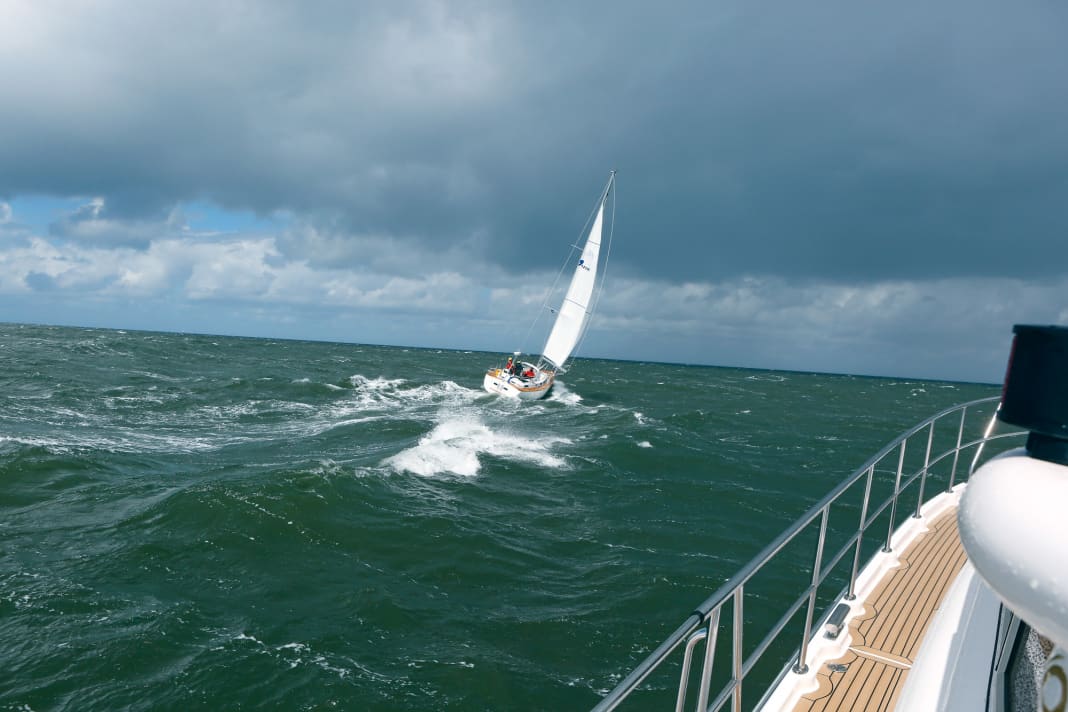





In this article:
Outside the hull, the water rushes past. The yacht is leaning so much to starboard in the stiff wind that spray is hitting the long saloon window to leeward. The waves make the hull buck. The rig is howling, rumbling, howling. Heavy weather under sail - just as you would imagine. But there's a catch: we're not at sea yet. We're moored up in the harbour, without canvas, with a bare mast.
A severe westerly gale has the North Sea so firmly in its grip that it is causing quite a stir even in the relative safety of IJmuiden's Seaport Marina. Its gale-force gusts of more than 50 knots at its peak are responsible for the fact that our almost 13-metre-long cruising yacht is making "speed" through the water even on the floating dock.
Sheltered from the lashing rain and the fine sand blowing over the dunes from the beach, we can at least make ourselves comfortable below deck and discuss the situation over a beer. There is a good reason for this, because this story was actually planned quite differently.
The aim: compare prices, journey times, consumption- and experience the charm of the other genre
Together, YACHT and BOOTE wanted to experience for themselves what the "other side" is all about on a joint trip with two ships. The motorboat drivers would switch to the sailing boat, while their sailing colleagues would switch to the motor yacht. Of course, we were primarily focussing on the positive aspects, and in good weather, of course. It was actually a completely normal trip, just on a different keel. We wanted to compare courses, journey times and fuel consumption. Above all, however, we wanted to understand the appeal of this unfamiliar type of vessel.
For the boats, the choice fell on two models already tested by the editors: a C-Yacht 12.50i for us, a high-quality touring boat with centre cockpit, furling genoa and furling mainsail; and an Elling E4 for the sailors, at 15 metres in length an extremely stately appearance, with striking lines and powerful turbo-diesel propulsion, at the same time planing but also suitable for rough water.
To England in ten force winds? Unseamanic madness!
As both yachts are built in the Netherlands, IJmuiden was the obvious port of departure - for a short trip to England, including an English breakfast in a pub in Great Yarmouth or Lowestoft, before heading back to the Dutch coast. At least that was the plan.
However, we had not taken the storm into account. Sticking to our destination would have meant tacking all the way to the island, which, in the case of the sailing yacht, would have meant time-consuming crossing even at 6 Beaufort. At 10 Beaufort, on the other hand, it would simply have been torture - for both crews, for both boats. Even more: unseamanic madness.
We therefore decide with the two skippers to spend the night in the harbour and only set sail the next day when the storm has abated somewhat. Then we should set off, one way or another. But not to England as originally intended, but on a more favourable course along the coast to the north. The destination: Oudeschild on the island of Texel.
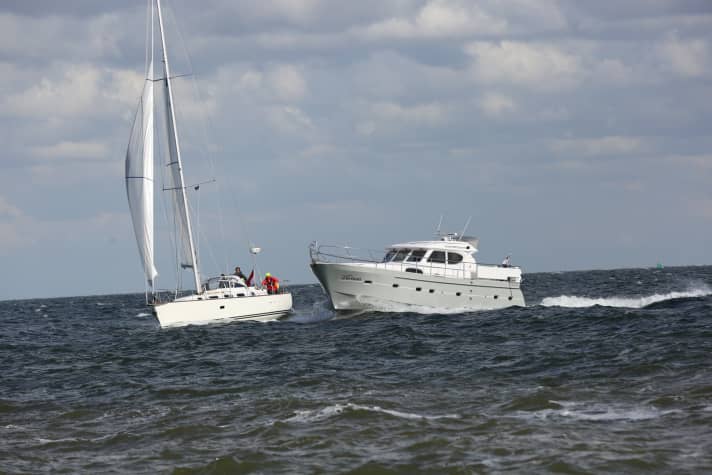
Leaving: "Is that necessary?"
The sailor: There's already a metre of wave in the outer harbour, out on the North Sea it's three to four metres. That's great!
Anton van den Bos, the boss of Elling, did not miss the opportunity to be there himself. He loves adventure, and he radiates a confidence in his boats that goes far beyond the expected marketing gimmickry. You could almost think he had wished for heavy weather for this trip. A few years ago, he sailed across the Atlantic with three E4s and plenty of extra fuel tanks. Last year, he had himself strapped into his flagship and turned upside down by crane, documented by a dozen cameras. He wanted to show that his boats are designed to be self-righting, he says gleefully - "just like sailing yachts".
The video is intended to reassure people like me who are switching to the E4 and emphasise its seaworthiness. Van den Bos had bright orange jackets embroidered especially for this, with the Elling logo on the chest and "360°" on the back. He is wearing one of them today. Is it self-confidence or self-suggestion? It's certainly reassuring - a little. Just like the door to the wheelhouse, which falls heavily into the lock like a safe. Just like the name of the boat on the towering bow: "Fortuna". It will go wrong somehow.
It lacks the directness, the feedback that is so natural on sailing boats.
A herd of broncos comes to life in the cellar
When we cast off, the wind is still blowing at 35 to 40 knots through the wide harbour basin. The Elling is moored on a finger jetty, the wind is blowing sideways onto the boat. Tricky, not to say stressful? Not here: With transverse thrusters at the bow and stern, the 15-metre boat can be held in position at the touch of a button and easily driven out of the box. Anton van den Bos remains silent and smiles.
The view from the elevated wheelhouse is unrivalled, you have everything in view ahead and to the side. Only the high ratio rudder and the comparatively small wheel take some getting used to in the confines of the harbour. It lacks the directness, the feedback that is so natural on sailing boats.
And something else is different - the presence of the engine can be felt rather than heard. The six-cylinder turbodiesel with a displacement of 5.5 litres hums two metres below the steering position - a unit powerful enough to drive coaches or heavy goods vehicles. I push the electronic control lever forward just a little and a herd of wild broncos comes to life in the basement.
On the open sea: box seat in the chaos
The motorboater: the nose in the wind, the water within reach, the waves as a boost for long, fast surfs
Only when we have already left the pier heads a good distance behind us can I have a proper look round. The impressive realisation: how close you are to the water! Normally, I only know the view of the waves in bad weather from the relative shelter of the wheelhouse - or at least from the elevated position of the outside steering position in the cake stand on the aft deck. Quite apart from the fact that, as a motorboat driver, you don't stick your own bow out of the harbour in such circumstances anyway.
Here, in the narrow cockpit, the front end of which is bordered by the companionway while the helmsman holds the large wheel in both hands aft, you are at eye level with the sea - and often enough below it. Because that's how high the waves are today, around three to four metres. Some of the breaking crests are so high that the Elling, which keeps circling us at a safe distance with the power of its engine, often disappears completely when we are in a wave trough. But just a few moments later, we are lifted up again to a box seat in the grey chaos that reigns all around us.
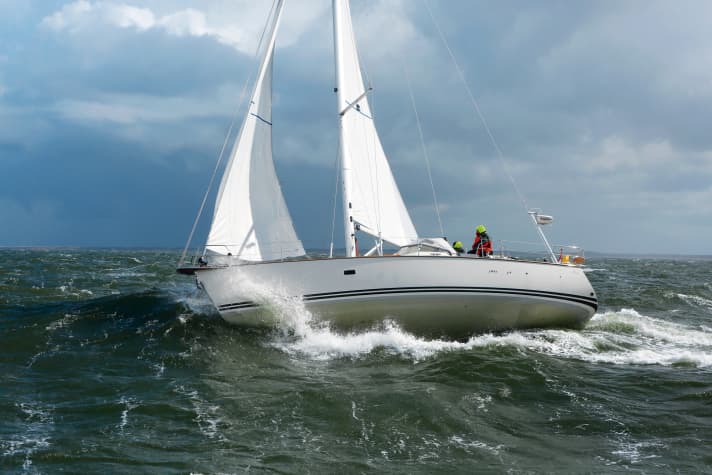
The wind is coming in from the port side, i.e. a little further astern than abeam. 8 Beaufort. That's no longer a storm, but it's still stormy enough. The mainsail and genoa are double reefed and the winches sing when our boatswain adjusts the sail position to the wind direction and strength.
The "iron hand in the velvet glove"
The C-Yacht begins to surf on the travelling wave crests and the mood rises. There is great jubilation when the digital display on the companionway reads 12.1 knots! Again and again the bow lifts out of the water, shoots forwards and the spray flies far aft.
You won't get far here with the average motorboat weather clothing - i.e. a light rain jacket.
The sprayhood between the mast and the companionway doesn't keep out much more spray than the windscreen of a convertible in the rain. If you don't turn away in time, you'll have the fresh North Sea in your face. The average motorboat weather clothing - i.e. a light rain jacket - won't get you far here. Oilskins and boots are mandatory, as are an automatic waistcoat and a safety line, which must always be fastened.
Then - after a short briefing - comes my turn at the helm. One leg on the cockpit floor, the other on the leeward bench to compensate for the heeling, the large compass on the steering column in front of me, I try to maintain a course of 010 degrees, which takes us further north along the seemingly deserted coast with its seaside resorts crouched behind the dunes. Every wave that passes under the stern, every shift in the wind, every movement of the yacht is immediately felt on the steering wheel via the rudder blade. The skipper whispers to me from the side that it is important to exert just the right counter-pressure with feeling - and I am reminded of the image of the "iron hand in the velvet glove" that an experienced sailor once told me about. The feeling of standing aft here is really something very special.
Storm trip in a motorboat
The sailor: In the shelter of the elevated wheelhouse, the weather seems tamed - except for the rolling
Last night, in the seclusion of the forward cabin, I had imagined the journey as if in an endless loop. I had seen the waves piling up in front of us, the breaking crests, the streaks of foam that the wind swept into the green-grey water. But I hadn't even begun to imagine how the Elling would behave in it. My experience with motorised ships in heavy seas has so far been limited to photo boats, ferries and the Queen Mary II - some of which are much smaller and more manoeuvrable, others much larger and more sluggish than the E4.
To be on the safe side, I let Anton van den Bos take the wheel for the first few miles off the coast. These are the roughest, the most unsettling. Because we first have to gain some safe sea room before we can drop off to the north - otherwise we would be too close to land, too close to the surf belt. The North Sea is choppy enough as it is, because the wind and tide and the topography of the seabed outdo each other in putting breakers in our path.
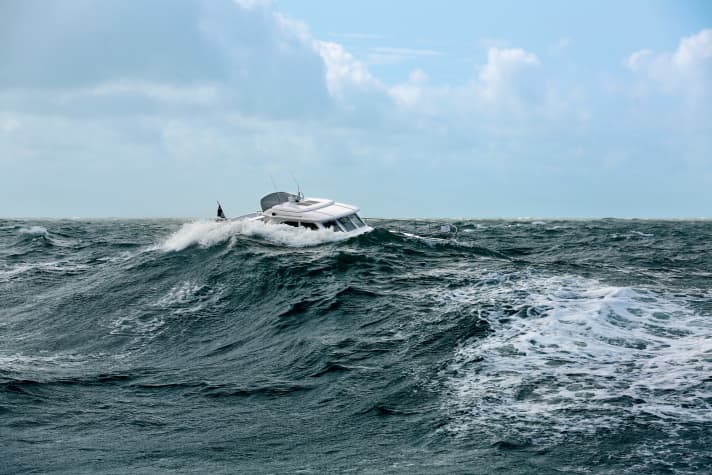
At a slow speed, 6 to 7 knots only, we steer the Elling slightly higher than a half-wind course into the full-grown cavemen. When the hull tilts into the trough of the wave, a tremor runs through the bracing. Water shoots up from the bow and over the forecastle before noisily hitting the wheelhouse's safety windows. It's like an explosion in slow motion, the force of which doesn't quite match our speed. Of course, it would be unthinkable to go any faster now - not in this sea, not on this course. Three wipers make a real effort to restore the good visibility. They seem almost a little helpless.
Swaying and swaying on all axes
And yet it is nothing short of a miracle how stoically the boat endures the battering. The windows withstand the fountains of water and don't let a drop through. The aft-opening convertible top also remains tight, the fittings in place. No cupboard breaks out of its anchorage, which is said to happen on other motorboats in such conditions. Hardly any twisting noises. Only the crockery rattles in the locker.
Outside, raging seas and roaring winds. And inside, we are as safe as in a space capsule that keeps all the power of the weather away from us.
The situation seems almost surreal. Outside, raging seas and roaring winds. And inside, we are as safe as in a space capsule that keeps all the power of the weather away from us. Well, almost. The Elling can't do anything against the pitching, yawing and rolling of the ship. Anton van den Bos, an engineer by trade, is already thinking about a gyro-stabiliser, a flywheel driven by an electric motor in the middle of the ship, whose rotational momentum should dampen the movements in rough seas. But this is probably reserved for his new flagship, the E6, for the time being and is only available as an expensive option.
Looking into the abyss
"Fortuna", on the other hand, rocks and sways on all axes as long as we take the waves slightly more forwards than abeam. Her behaviour is similar to that of a catamaran, except that the amplitudes are more pronounced and the pitching more jerky. The only unpleasant thing is rolling around the longitudinal axis, because you really have to wedge yourself against it. The most extreme angles are 35 to 40 degrees to either side, which feels more dramatic than it is. If you look sideways out of the wheelhouse, you occasionally see a five or six metre deep abyss. In fact, the Elling would also turn back into a vertical position from more than 90 degrees - as the YouTube video and Anton van den Bos' orange jacket prove. You just have to tell yourself quietly from time to time that it's not as bad as it looks.
Fun? Not really. Rather an amazement at the seaworthiness that was hardly thought possible.
Incidentally, the shipyard manager also shows slight signs of tension at first, but this eases with every mile. And even the sailor at the helm gets used to stormy sailing without a rig. It requires even more concentration in the waves than sailing straight ahead in the harbour, but it works. Fun? Not really. More like amazement at the seaworthiness we hardly thought possible.
Even after dropping off, with the wave now coming from diagonally astern, there is no real joy. Of course, we could accelerate now and cruise towards Texel at 18 or 19 knots, which we do for a while as a test. But firstly, the consumption meter then shows a good 80 litres of diesel per hour, ten times as much as before. And secondly, we want to accompany the sailors on their ride. They sit outside in the cockpit, wrapped up in oilskins, while we follow their battle with wind and waves in the warm wheelhouse. The autopilot has long since taken over the tiresome steering on "Fortuna".
Run-off: a real sense of togetherness
The motorboat driver: the swell subsides in the shelter of an offshore sandbank. All the strain is immediately forgotten
What a contrast! Just a moment ago we were in the middle of the grey turmoil, now the sea around us has suddenly calmed down. The C-Yacht only rocks gently back and forth as we enter the Marsdiep, which separates the northern tip of the Noord-Holland peninsula from Texel, with the tidal current from the Schulpengat.
The force of the onrushing waves is now broken in the west, where a line of white breakers marks the course of the protective Haaks sandbank. On the starboard side, cyclists on the top of the dyke are being pushed by the stiff wind, and the towering Kijkduin lighthouse is also a sure sign for us that today's adventure is coming to an end.
Special group dynamics when cruising
Even the sun is now making an appearance and the initially small wisps of blue above us are getting bigger and bigger. Slowing down is the order of the day: while until recently we were sitting close together in the cockpit, facing each other and enduring one cold shower after another for hours with grim equanimity - a real sense of togetherness, by the way, which certainly contributes a lot to the special group dynamic when cruising - we now stretch out relaxed and, in my case at least, comfortably exhausted to dry off: aft on the side deck between the cockpit and the railing or on the foredeck under the widely flared jib. The hunger is now also coming on with a vengeance, and the chilli con carne, which is served in large mugs from the galley, couldn't taste any better.
Our two ships move quietly alongside each other, and the Elling is now also seen on deck again. We wave to each other, eager to hear the others' stories about how they experienced this day on unfamiliar planks. Den Helder passes by and our odd couple swings into Texelstroom. Oudeschild is now practically round the corner - and the open North Sea seems very far away again.
Sailing yacht against motorboat- the conclusion
The sailors had an experience, the motorboat crew a rest - and an unexpectedly calm North Sea experience
The "Fortuna" has long been firmly moored when the C-Yacht comes alongside. No sails to furl or unfurl - another comfort plus of the motorboat. Faster out, faster into the harbour, and if it's not too choppy, even faster on the way. This makes afternoon trips just as effortless as longer journeys. And it requires far less seamanship. This is probably why many market observers predict higher growth rates for the powerboat faction. The age of the owners also plays a role. The last boat often no longer has a mast, they say. Van den Bos sells "almost every second boat to a former sailor".
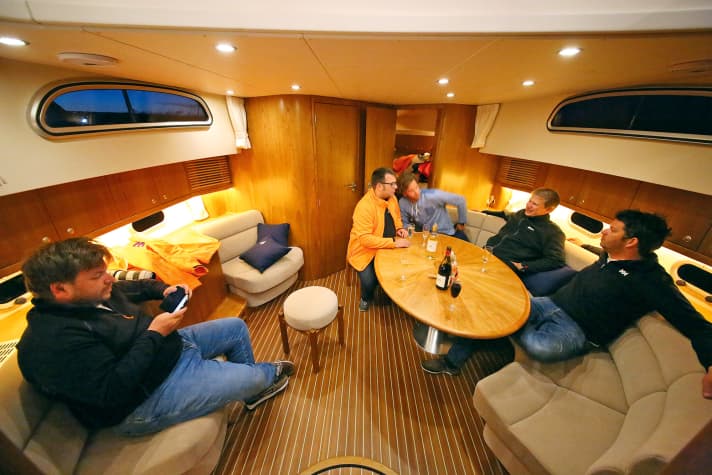
For après-sail, everyone meets on the Elling as a matter of course. Her raised aft deck takes the crews away from the hustle and bustle of the harbour. Only modern cruising catamarans with a rooftop sun deck offer a comparable panoramic view. And the saloon is also a great place to end an evening in a larger group: more square metres, more comfort. Just as everything on the motorboat is more like the surroundings you are used to at home. In the case of the E4, this ranges from the hot water central heating to the induction hob in the galley. It's actually as if you haven't really left home at all.
Experience on the sailing boat, uneventfulness as the premise of the motor yacht
Well, from an ecological point of view, there may be reservations about the type of propulsion and the downright painful fuel consumption at full load. Economically, the balance sheet for the sailing yacht also looks more favourable at first glance. But that is deceptive. For the equivalent value of a new set of good sails, you can travel several thousand miles on a motorboat.
I had the feeling that she didn't need me at all.
The decisive difference lies elsewhere. You could see it in the C-Yacht crew's cheeks, red from the cold and exertion, and hear it in their lively stories. The sailors had reefed in and out several times, taken on buckets of water and constantly endured the biting breeze around their noses. For the last few miles, they had had to cross laboriously before the wind. They had exhausted themselves and overcome a challenge. In other words, they had really experienced something.
What was special about the Elling was that, strictly speaking, no special effort was required and consequently there were no special incidents. That in itself is quite an achievement, almost a minor sensation. And many people will love her for it. But it is not a comparable experience. Maybe that's why my eyes closed three times. I had the feeling that she didn't need me at all. And that's how it was.
The boats in comparison
The yachts differ not only in their main drive, but also in their length - a direct comparison is therefore not possible. However, they are similar in their design. Both are built to a very high standard and are fully suitable for long journeys
C-Yacht 12.50i

- Design engineer:Frans Maas
- Lüa (torso length): 12,88 m
- Width:3,90 m
- Depth: 1,80 m
- Mast/clearance height: 19,20 m
- Weight: 11,0 t
- Sail area on the wind: 81 m²
- Engine power: 42 kW/57 hp
Elling E4

- Design engineer:Ken Freivokh
- Lüa (torso length): 14,95 m
- Width:4,25 m
- Depth: 1,30 m
- Mast/clearance height:3,45 m
- Weight: 13,0 t
- Sail area on the wind: -
- Engine power:313 kW/435 hp

